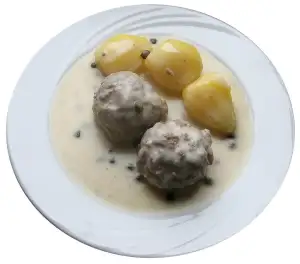Master the Art of Making Roux: A Delectable Recipe for the Perfect Base

Roux is a fundamental ingredient in French and Cajun cuisine, known for its ability to add depth and richness to dishes. It is a simple mixture of flour and fat, traditionally made with equal parts of flour and butter. The process involves cooking the flour in the fat until it reaches a desired color, which can range from pale yellow to deep brown. This technique not only thickens sauces and soups but also imparts a nutty flavor that enhances the overall taste of the dish. Whether you're a seasoned chef or an amateur cook, mastering the art of making roux will elevate your culinary skills and open up a world of delicious possibilities.
Ingredients required for making Roux
To make the perfect Roux, you will need just two simple ingredients: flour and fat. The most commonly used fat for making Roux is butter, but you can also use other fats like vegetable oil or bacon grease for a unique flavor. As for the flour, all-purpose flour works best, although you can experiment with different types of flour such as whole wheat or gluten-free options if desired. The ratio of flour to fat is typically 1:1, meaning equal parts of each ingredient. However, if you prefer a lighter or darker Roux, you can adjust the ratio accordingly. Just remember that the consistency of your Roux will depend on the amount of fat and flour used. So gather your ingredients and let's get started on mastering the art of making Roux!
Step-by-step instructions for making Roux
1. Start by gathering the ingredients: equal parts of flour and fat (such as butter or oil).
2. Heat a heavy-bottomed saucepan or skillet over medium heat.
3. Add the fat to the pan and allow it to melt completely.
4. Once the fat has melted, gradually add the flour to the pan while continuously whisking or stirring with a wooden spoon.
5. Continue stirring constantly until the mixture turns into a smooth paste-like consistency.
6. Adjust the heat if necessary to prevent burning, as roux can easily scorch.
7. Cook the roux for a few minutes, stirring constantly, until it reaches your desired color. The longer you cook it, the darker and richer the flavor will be.
8. For a white or blonde roux, cook for about 2-3 minutes until it becomes slightly golden in color.
9. For a brown roux, continue cooking for an additional 5-10 minutes until it turns a deep caramel color.
10. Remove from heat and let it cool slightly before using in your recipe.
Remember that roux is typically used as a thickening agent in sauces, soups, and stews. The ratio of flour to fat can be adjusted depending on how thick you want your final dish to be. Experiment with different types of fats and flours to achieve unique flavors and textures in your recipes. Enjoy mastering this essential technique that adds depth and richness to your culinary creations!
Tips and variations for making Roux
Tips and Variations for Making Roux:
1. Choose the right fat: While traditional roux is made with butter, you can experiment with other fats like vegetable oil or bacon grease to add different flavors to your roux.
2. Control the heat: It's important to cook roux over low to medium heat to prevent burning. Stir constantly and adjust the heat as needed to maintain a gentle simmer.
3. Use a whisk: A whisk is the best tool for making roux as it helps incorporate the flour into the fat evenly and prevents lumps from forming.
4. Experiment with different ratios: The ratio of flour to fat determines the thickness of your roux. For a lighter consistency, use less flour, and for a thicker base, increase the amount of flour.
5. Add aromatics: To enhance the flavor of your roux, consider adding finely chopped onions, garlic, or herbs during the cooking process.
6. Explore different colors: The longer you cook your roux, the darker it becomes, resulting in deeper flavors. Experiment with different cooking times to achieve light blonde, golden brown, or dark chocolate-colored roux.
7. Gluten-free options: If you're following a gluten-free diet, substitute wheat flour with alternative flours like rice flour or cornstarch to make a gluten-free roux.
Remember that practice makes perfect when it comes to making roux. Don't be afraid to experiment and adapt the recipe according to your taste preferences and culinary needs.
Common uses of Roux in cooking
Roux is a versatile ingredient that adds depth and flavor to a wide range of dishes. Here are some common uses of Roux in cooking:
1. Sauces: Roux is the base for classic sauces like béchamel, velouté, and hollandaise. It provides a smooth and creamy texture, making it perfect for dishes like macaroni and cheese or creamy mushroom sauce.
2. Soups and stews: Roux acts as a thickening agent in soups and stews, giving them a rich and velvety consistency. It can be added to gumbo, chowders, or even hearty beef stew to enhance the flavors and create a satisfying meal.
3. Gravies: Roux is essential for making flavorful gravies. Whether it's turkey gravy for Thanksgiving or brown gravy for roasted meats, adding a roux creates a luscious texture and enhances the taste.
4. Casseroles: Many casseroles rely on roux to bind the ingredients together while adding flavor. From chicken pot pie to shepherd's pie, roux helps create a cohesive dish with a delicious sauce.
5. Quiches and tarts: Roux is often used as the base for quiche fillings or savory tarts. It helps set the custard-like filling while providing richness and depth of flavor.
6. Pasta dishes: Roux can be incorporated into pasta dishes like lasagna or baked ziti to create a creamy sauce that coats every noodle perfectly.
7. Vegetable side dishes: Adding roux to sautéed vegetables creates an indulgent side dish with added creaminess and flavor.
In conclusion, mastering the art of making roux opens up endless possibilities in your culinary adventures. Its versatility makes it an essential technique to learn for both home cooks and professional chefs alike. Experiment with different variations and explore its various uses to elevate your dishes to new heights.
In conclusion, mastering the art of making roux is a game-changer in the culinary world. This simple yet versatile base adds depth and richness to countless dishes. By combining equal parts fat and flour, you can create a velvety smooth mixture that forms the foundation for many classic sauces, soups, and stews.
Whether you prefer a light blonde roux or a dark chocolate-colored one, the key lies in patience and attention to detail. Remember to cook your roux over low heat, stirring constantly to avoid burning. The end result should be a fragrant mixture with a nutty aroma.
Experiment with different fats such as butter, oil, or even bacon drippings to add unique flavors to your roux. You can also play around with alternative flours like cornstarch or rice flour for gluten-free options.
Once you've mastered the art of making roux, the possibilities are endless. Use it as a thickener for gravies and sauces, or as a base for creamy macaroni and cheese. It's also perfect for adding body to gumbo, jambalaya, or hearty beef stew.
So why not embark on this flavorful journey and elevate your cooking skills? With just a few simple ingredients and some practice, you'll be able to create delicious dishes that will impress family and friends alike. So go ahead and give this delectable roux recipe a try - your taste buds will thank you!
Published: 17. 02. 2024
Category: Recipes



